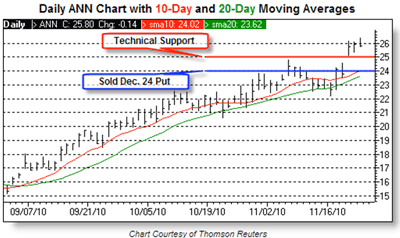The shares of women’s clothier Ann Taylor Stores Inc. (ANN) have tagged a series of fresh annual highs during the past several sessions, as traders react to recent stronger-than-expected quarterly results. The stock vaulted past former technical resistance in the $24.50-$25 region, and is currently consolidating those gains just above the $25.50 level. Heading into the report, ANN enjoyed the solid support of its ten- and 20-day moving averages.
Given today's market turmoil and global uncertainly, many investors would be loath to open up a fresh long position on ANN, despite the stock's strong position from a contrarian standpoint. Luckily for options traders, there is more than one way to bet somewhat bullishly on a stock without needing the shares to rocket sharply higher. In fact, one of the more popular—and least complicated—methods for taking advantage of a technical pattern similar to ANN's is to sell option premium by opening a put-sell position.
For example, I uncovered just such a trade buried within ANN's wealth of put volume today. Specifically, a block of 5,500 December 24 puts traded on the New York Stock Exchange (NYSE) at about 9:52 am for the bid price of $0.45, or $45 per contract. Open interest at this strike currently totals 6,341 contracts, indicating that this activity could, instead, represent the closure of an existing short position. But, for the purposes of today's example, let's assume that this block is a straight up put-sell position.
So, after selling 5,500 December 24 puts for $0.45, the trader will receive a credit of $45 per contract, or a hefty $247,500 total—(0.45 x 100) x 5,500 = $247,500. In order for the trader to retain the entire premium received, ANN needs to hold above the $24 level through December 17, when these options expire.
The maximum theoretical loss on this position is limited to the strike price minus the premium, or $2,355 per contract should the stock go to zero, while the maximum profit is capped at the initial premium received when the options were sold. Below is a profit/loss graph for a visual representation:
Implied Volatility
Rising implied volatility can be deadly to a put-sell trader, as it lifts the value of the sold option, potentially increasing the cost to buy back the contract if the underlying stock moves sharply against you. Declining volatility, meanwhile, has the opposite effect, making it less expensive to repurchase the option should the need arise. At the time of the trade, “implieds” for the ANN December 24 put were 46.83%. For comparison, ANN's one-month “implieds” rested at 18.49% as of the close of trading on Monday. By Joseph Hargett, contributor, Schaeffer’s Trading Floor Blog





















